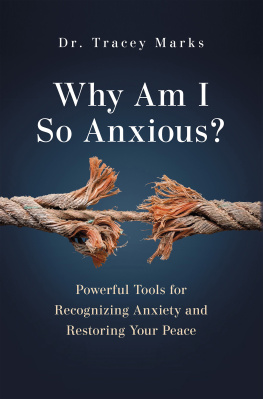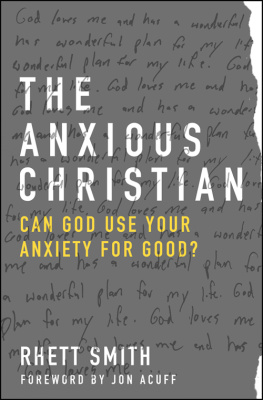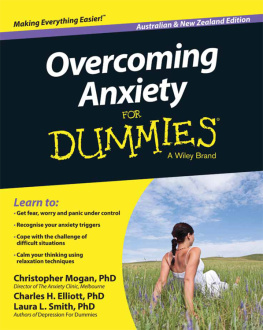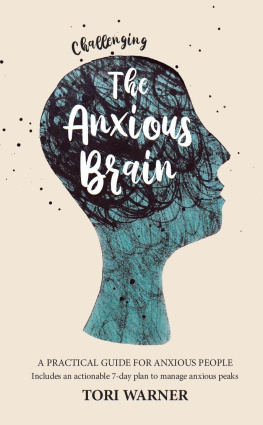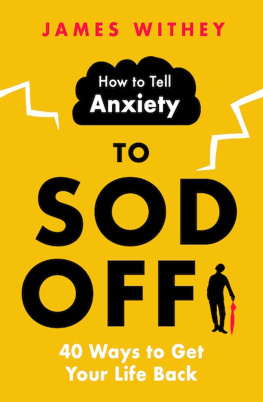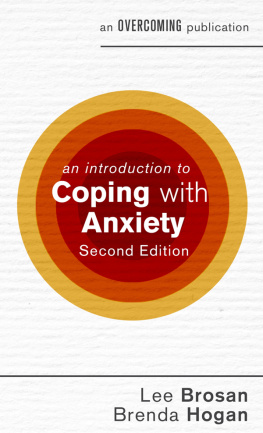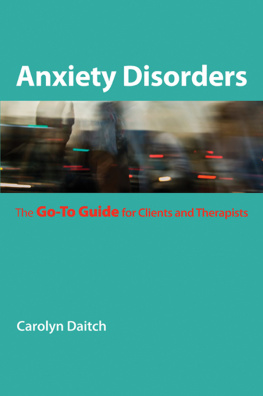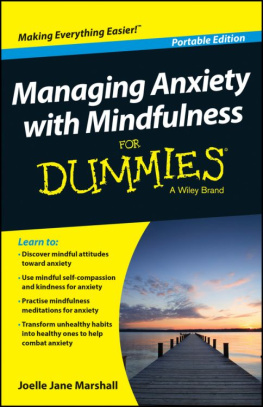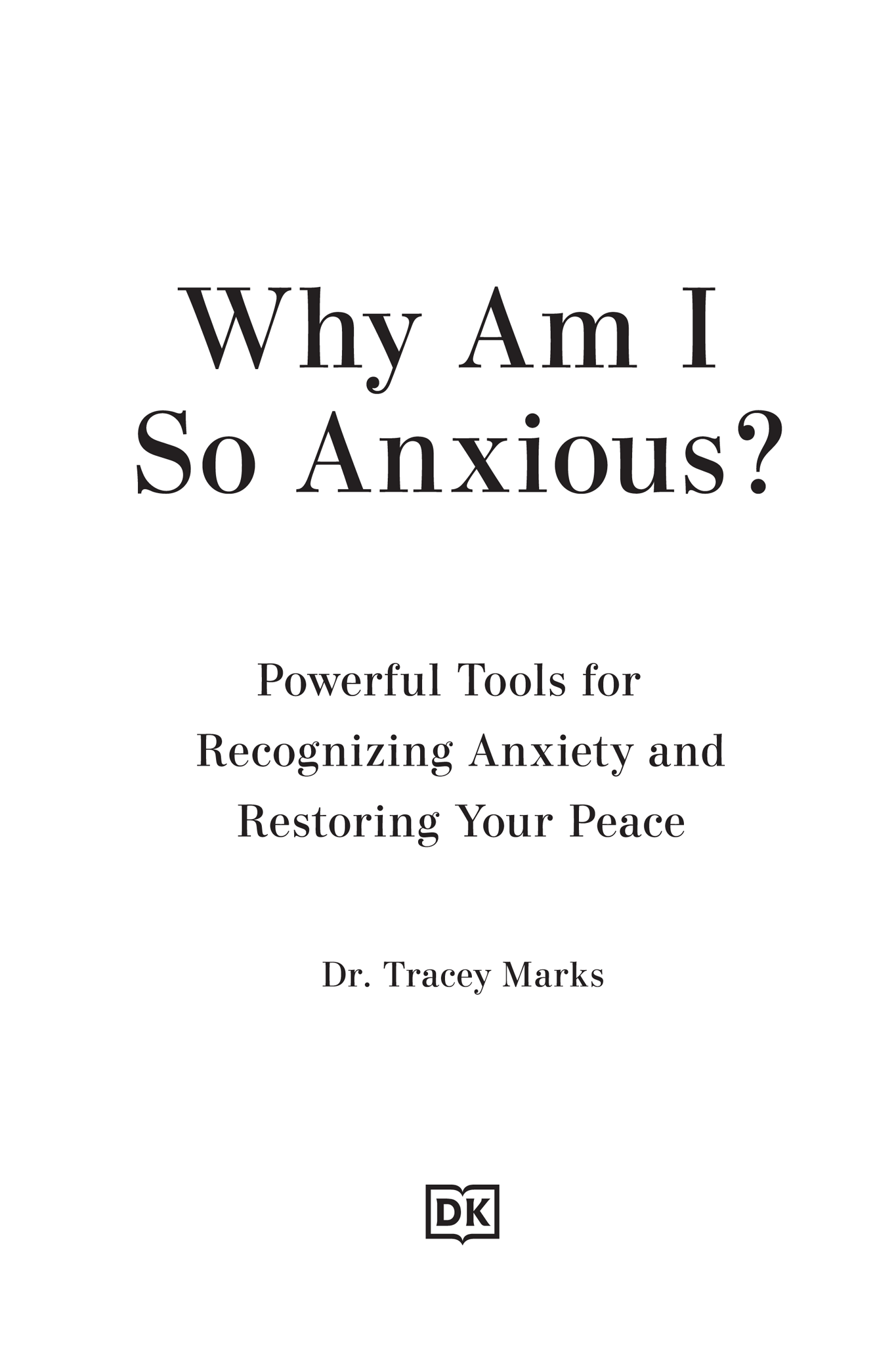Contents
Landmarks
Contents
How to use this eBook
Preferred application settings
For the best reading experience, the following application settings are recommended: Orientation: Portrait
- Color theme: White background
- Scrolling view: [OFF]
- Text alignment: Auto-justification [OFF](if the eBook reader has this feature)
- Auto-hyphenation: [OFF](if the eBook reader has this feature)
- Font style: Publisher default setting [ON](if the eBook reader has this feature)
- In Settings, change the font size to a size you are most comfortable with.
Introduction
Sometimes, anxiety is like the sea: it ebbs and flows, but its always there. Other times, its like a chameleon: it can take many forms, some of which may not be obvious. We all experience anxiety at some level. What matters most is how it affects you and how you manage it.
I wrote this book during the COVID-19 pandemic, which is an unprecedented time that has universally affected us. If you didnt struggle with distressing anxiety symptoms before, COVID might have introduced you to the experience.
So for many people, the answer to the question Why Am I So Anxious? could be summed up in one word: COVID. But anxiety is so much more than the effect of a situational disaster. While disasters can make anxiety worse, anxiety is part of the human experience; it will persist, independent of an infectious outbreak or other natural disaster.
As such, I purposely left COVID out of my explanations of the origins of anxiety. Part of me had hoped that by the time I finished writing, COVID would be over. As of the date of this writing, its not, and that doesnt change the books message. It may make the need for tools to manage your anxiety even more essential.
I wrote this book to give you a deeper understanding of the different factors that can influence how anxious you feel. Not all anxiety is a disorder, and sometimes anxiety stems from your personality. If youve been diagnosed with a disorder or wonder if you have one, the chapters discussing anxiety disorders can help you see if you should seek further professional help. I also help you understand how much anxiety is normal and when it might be appropriate to take medication.
I hope this book eases some of the frustration of figuring out how to manage your anxiety. As a psychiatrist, I mainly prescribe medication for anxiety disorders, with psychotherapy to address specific issues. I have found over the years that by the time someone comes to see me (the prescriber), they are fed up with natural interventions and want an end to their sufferingyesterday. The prescribed medications often work as expected to reduce or eliminate their anxiety, and all is well until the side effects appear. Usually, the best-case scenario is a little weight gain and mild fatigue. But as you will see in , where I talk about prescription medicines, there are a lot of downsides to taking medication.
Often, when I try to introduce complementary and alternative therapies like diet and lifestyle interventions, the person will inevitably say, I tried all that, and it doesnt work. In reality, a person may feel too overwhelmed to sort out all possible interventions on a trial-and-error basis. Like my patients, I got frustrated with the many options that are supposed to work but dont.
Then it hit me. My patients and I were expecting the alternative approaches to work the same way as medication with one solution to handle all the symptoms. But thats too much to expect from a nonprescription option. Its not even realistic for the medications to address all anxiety symptoms. Thats why most people dont have 100% improvement with the medications.
Whats the answer to this dilemma? How do you address anxiety without medication?
The answer is avail yourself of a variety of tools that address different aspects of anxiety and layer the tools to get the maximum effect. In the second half of the book, I equip you with several tools to address your anxiety.
Many options can still leave you feeling overwhelmed if you try to apply all of them. I suggest you read through the book to get the big picture and then return to the chapters that resonates with you the most. In the appendix, I present some summary tables and additional information to help you focus on the tools that will work best for you in diverse situations.
Happy reading, and Ill see you on the other side.
PART 1
Anxiety Origins
Part 1: Anxiety Origins | Contents
CHAPTER 1
Understanding Different Aspects of Anxiety
The Biology of Anxiety
Everyone has experienced anxiety at some level. Even if you are the calmest, most nonreactive person in the world, you have been anxious. Its a physiological fact. We all are wired to experience a hyperarousal state in response to an environmental stressor. When we perceive a threat, we instinctively respond with apprehension and caution.
This apprehensive response is why some people think of anxiety as being synonymous with fear. After all, fear is scary and being afraid causes distress. But fear is only one aspect of anxiety. Fear is your emotional response to a perceived threat that is imminent. The threat may be hypothetical, like something you imagine happening, or it can be real and forthcoming.
On the other hand, anxiety is the anticipation of a future threat. This threat can be real or imagined, but its not immediate. An example of anxiety triggered by a nonimminent threat is worrying that you may lose your job if your company doesnt generate enough business.
The physiological reaction your body has to a threat is not pathological anxiety. Its a normal hyperarousal state. Typically, once the threat has passed, the hyperarousal state subsides. But for some people, the vigilance can develop into fear and trepidation and persist beyond the threat. Or worse, it can appear in the absence of any recognizable threat. This persistent fear creates pathological anxiety.
A Brief Tour of the Brain
Scientists refer to the normal hyperarousal stateyour automatic stress reactionas the flight, fight, or freeze response. These responses originate deep inside the brain and help you mobilize the energy you need to deal with a dangerous situation.
Imagine that your brain is a theater. It has an upper level, a lower level, and an orchestra pit. The lower level houses the subcortical structures, like the amygdala and thalamus, which handle instinctual drives (safety, sexual needs, etc.). They are encased inside the brain and out of view. Some people call this your lizard brain, as it acts on instinct and learned memories rather than logic. Your subcortical structures also store emotional memories.
In the upper level, youll find the cortex. This includes the outer surface of the brain, which you see in pictures as wrinkled grey matter. Just as you get a higher-level view of a performance from this level, the cortex handles higher-order functions, like thinking and interpreting the emotions created by subcortical structures.
In the orchestra pit sits the conductor and the musicians. This is your midbrain: a conductor coordinating complex signals from the cortex and subcortex down through the brain stem, spinal cord, organs, and periphery.

